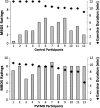The Effect of Exercise on Respiratory Resistance in Athletes With and Without Paradoxical Vocal Fold Motion Disorder
- PMID: 26001627
- PMCID: PMC4657526
- DOI: 10.1044/2015_AJSLP-14-0110
The Effect of Exercise on Respiratory Resistance in Athletes With and Without Paradoxical Vocal Fold Motion Disorder
Abstract
Purpose: An investigational, portable instrument was used to assess inspiratory (R(i)) and expiratory (R(e)) resistances during resting tidal breathing (RTB), postexercise breathing (PEB), and recovery breathing (RB) in athletes with and without paradoxical vocal fold motion disorder (PVFMD).
Method: Prospective, controlled, repeated measures within-subject and between-groups design. Twenty-four teenage female athletes, 12 with and 12 without PVFMD, breathed into the Airflow Perturbation Device for baseline measures of respiratory resistance and for two successive 1-min trials after treadmill running for up to 12 min. Exercise duration and dyspnea ratings were collected and compared across groups.
Results: Athletes with PVFMD had lower than control R(i) and R(e) values during RTB that significantly increased at PEB and decreased during RB. Control athletes' R(e) decreased significantly from RTB to PEB but not from PEB to RB, whereas R(i) did not change from RTB to PEB but decreased from PEB to RB. Athletes without PVFMD ran longer, providing lower dyspnea ratings.
Conclusion: Immediately following exercise, athletes with PVFMD experienced increased respiratory resistance that affected their exercise performance. The difference in resting respiratory resistances between groups is intriguing and could point to anatomical differences or neural adaptation in teenagers with PVFMD. The Airflow Perturbation Device appears to be a clinically feasible tool that can provide insight into PVFMD and objective data for tracking treatment progress.
Figures


Similar articles
-
Short-Term Intensive Therapy and Outcomes for Athletes With Paradoxical Vocal Fold Motion Disorder.Am J Speech Lang Pathol. 2019 Feb 21;28(1):83-95. doi: 10.1044/2018_AJSLP-17-0223. Am J Speech Lang Pathol. 2019. PMID: 30453332 Clinical Trial.
-
Test-retest reliability of respiratory resistance measured with the airflow perturbation device.J Speech Lang Hear Res. 2014 Aug;57(4):1323-9. doi: 10.1044/2014_JSLHR-S-13-0246. J Speech Lang Hear Res. 2014. PMID: 24686535
-
Resting Respiratory Resistance in Female Teenage Athletes With and Without Exercise-Induced Laryngeal Obstruction.J Voice. 2022 Sep;36(5):734.e1-734.e6. doi: 10.1016/j.jvoice.2020.09.002. Epub 2020 Sep 26. J Voice. 2022. PMID: 32988702 Free PMC article.
-
Paradoxic vocal fold movement disorder.Otolaryngol Clin North Am. 2014 Feb;47(1):135-46. doi: 10.1016/j.otc.2013.08.014. Epub 2013 Oct 23. Otolaryngol Clin North Am. 2014. PMID: 24286687 Review.
-
Working Towards a Common Transatlantic Approach for Evaluation of Exercise-Induced Laryngeal Obstruction.Immunol Allergy Clin North Am. 2018 May;38(2):281-292. doi: 10.1016/j.iac.2018.01.002. Epub 2018 Feb 19. Immunol Allergy Clin North Am. 2018. PMID: 29631736 Review.
Cited by
-
A longitudinal follow-up of continuous laryngoscopy during exercise test scores in athletes irrespective of laryngeal obstruction, respiratory symptoms, and intervention.BMC Sports Sci Med Rehabil. 2023 Jul 15;15(1):87. doi: 10.1186/s13102-023-00681-9. BMC Sports Sci Med Rehabil. 2023. PMID: 37454093 Free PMC article.
References
-
- Andrianopoulos M., Gallivan G., & Gallivan K. (2000). PVCM, PVCD, EPL, and irritable larynx syndrome: What are we talking about and how do we treat it? Journal of Voice, 14, 607–618. - PubMed
-
- Balkissoon R. (2007). Vocal cord dysfunction, gastroesophageal reflux disease, and nonallergic rhinitis. Clinical Allergy Immunology, 19, 411–426. - PubMed
-
- Balkissoon R., & Kenn K. (2012). Asthma: Vocal cord dysfunction and other dysfunctional breathing disorders. Seminars in Respiratory and Critical Care Medicine, 33, 595–605. - PubMed
-
- Beaty M., Wilson J., & Smith R. (1999). Laryngeal motion during exercise. The Laryngoscope, 109, 136–139. - PubMed
-
- Borg G. (1998). Borg's perceived exertion and pain scales. Champaign, IL: Human Kinetics.
Publication types
MeSH terms
Grants and funding
LinkOut - more resources
Full Text Sources
Medical
Miscellaneous

